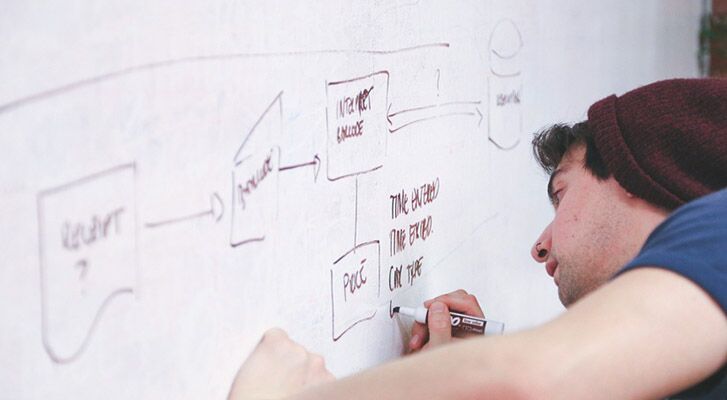If you’ve been at your Shopify Experts or web design business for any period of time, then you likely know the secret to success: presume positive intent.
Positive intent empowers you to approach client projects with an abundance mindset. Positive intent assumes your clients are open to fresh thinking. Positive intent promotes empathy toward your clients’ end consumers. Positive intent provides courage to solicit and receive feedback necessary to promote growth. Ultimately, positive intent is the precursor to persuasion.
If you’re like us at Rocket Code, we desire to wield the most persuasion possible with our clients. Our ambition is noble — we want to affect the most positive change we can for our clients’ ecommerce performance and customer happiness.
There are many ways to do good design work that clients value, respect, and ultimately choose to use. We don’t know all of them, but we have discovered many of them as well as a path that unites them into an effective force for preferable ecommerce experience designs.
Our path is imbued with the habits, attitudes, skills, points of view, and methodologies we have found invaluable to establishing ourselves as an authority on ecommerce designs that get results. If that path sounds exciting to you, then I hope you’ll journey forward and explore what we’ve learned.
Where does our path begin? Not with your clients, but rather with you and your potential for design excellence.
First, develop yourself into more than a one-trick designer
Eat, sleep, and breathe your design process

Good design is born from good design habits. Like everyday habits, design habits are either positive or destructive. The challenge for any designer bent on becoming an authority figure capable of great work that influences decision-making is to structure her process upon habits that push her creative powers forward in multiplicative ways.
Positive design habits take many forms: Consciously studying the form of a new print ad. Reading up on new functional design standards for the web. Obsessively sketching letters, symbols, and interfaces in a notebook. Consistently engaging with other designers, online and off, and debating what is a legitimate breakthrough versus what is just a fad. These habits and their kin are the embers of superpowers: instinct, intuitiveness, boldness, confidence, and versatility.
Total immersion is the path to such superpowers. The best designers aren’t just designers from 9-to-5. They doodle at night while watching television. They are the first to consume and critique new design patterns emerging from our industry’s most notable thought leaders. They are immediate and unrelenting with their feedback to consumer device makers when they botch key elements of a new operating system interface. They sketch, prototype, create, and then trash more work than they ever allow to see the light of day. This is the design process of the elite.
Do you — or your team’s designer — need to be elite to persuade your clients to choose your designs? Of course not. But the balance of probability shifts dramatically in your favor if you are, and that should be your goal. You can hack your way through a concept presentation, making up reasons or regurgitating the reasons of others for why you made certain design choices. Or you can truly own the substance of the conversation by promoting design concepts that are so fresh, informed, and on-point that they almost sell themselves. Advantage: you.
Total immersion is the path to superpowers.
Our creative director and lead designer, Dustin Tevis, exudes these qualities and embraces these habits more than any other designer I know. Yes, I’m biased, but wow. The caliber of his devotion to his craft is unsurpassed. If you’re a CEO or senior member of a team, you should aspire to hire a designer who impresses you in similar fashion.
At Rocket Code, we intentionally look for folks with these kind of habits to help us as we rapidly scale our Shopify Experts company. We want world-class talent because world-class talent is a consistent predictor of, and advantage toward, world-class results — namely delighting clients and their end customers with amazing designs that make a difference.
To reach this altitude, be willing to endure criticism. Criticism is elemental within the crucible of greatness. To forge these design habits into unbreakable superpowers, walk willingly into the arena and accept the challenges to come.
Invite criticism early and often to build confidence in yourself

The best designers I know are also the ones most actively sharing their work in public forums. The deeper I get into my career, the more I believe that this relationship isn’t coincidence: it’s a correlation slanting causation. Honest, sometimes brutal, reviews from peers and your industry at large are invaluable because they enable you to decipher what people want and need, inform your cause-and-effect judgment, elevate your velocity to do work, and improve your accuracy.
I look again at Dustin as a model for how to invite and harness the constructive power of criticism. He engages on design websites like Awwwards, Siteinspire, and Tympanus. He participates in design communities like Dribbble. He freelances on the side for a select set of clients who challenge him to innovate design paradigms. And he attends local design meetups and events like Startup Weekend whenever he can to mingle, talk shop, and give and take critiques from fellow designers.
I also look at Paul Jarvis, an accomplished designer who not only freely shares his work in public but also actively builds community and fans around his design ideas and knowhow. Paul cares as much about his work product as his work process. He talks about all of it on his blog, email newsletter, Medium collection, and other notable outlets around the web. Coincidently, by being so tremendously public with his work, lots of people disagree with Paul. Paul doesn’t mind and in fact welcomes the judgment because, as he writes in perhaps his most popular Medium essay, “If someone is offended by you, that’s because they’ve noticed you.” He builds the argument for inviting criticism and getting comfortable with it by saying, “greatness happens when you’re okay with being foolish/stupid,” and “self-respect leads to others respecting you.”
If the “others” Paul speaks of are your clients, why should they have any confidence in choosing your design concepts if they don’t respect you and your work? As leadership expert Simon Sinek says, “People don’t buy what you do; they buy why you do it.” That why begins and ends with a steadfast belief that your work delivers more value to your clients and their customers/users than any other option. When genuine, that belief in self fosters credibility, empathy, and trust in your work, which is precisely the magic you need to effectively persuade them to choose you.
Developing genuine self-confidence is not a one-time act. Like any roaring fire, self-confidence must be fuelled with consistent kindling in the form of criticism. That kindling keeps you humble. It motivates you to do better. And, if you’re lucky, it helps get you noticed for your good work. That’s the reason why I love opportunities like Shopify’s Commerce Awards. We submitted our recent work creating the new 47brand.com into that competition. We believe that the new user experience design (and all the engineering required to bring it to life) is among the best Plus-caliber work on Shopify. You may not agree. Shopify may not agree. That’s cool. We just want to know what our peers and partners think. We welcome all critiques; that’s how we get better.
Like any roaring fire, self-confidence must be fuelled with consistent kindling in the form of criticism.
Don’t limit your pursuits for confidence-building criticism to only the form of your designs. We live, work, and play in the world of ecommerce. Function is a very real and very necessary dimension to the design work we all do in this world. If your latest design looks pretty but cannot decrease cart abandonment rates, increase revenue per visitor, or otherwise elevate the shopping experience in economically viable ways, then your design fails a big litmus test. To pass that test and persuade more clients, learn the many design languages of the ecommerce universe.
Learn multiple design “languages”— in both form and function

Ecommerce happens everywhere. At home. On the train to work. In the airport lounge while waiting for a connecting flight. Ecommerce also happens for different emotional reasons. To find that one perfect thing to celebrate an anniversary. To quickly replace a broken gadget before leaving on a business trip. To indulge a quick obsession made stronger thanks to a personalized promotion. Being able to design shopping experiences that align with this range of diversity is the paramount challenge for would-be prolific ecommerce designers.
To become prolific, I don’t believe in the legacy notion of a “house brand.” House brands don’t respect the abundance of the ecommerce universe. For example, if you’re working with the Acme company, don’t bias the design of their mobile ecommerce store with the same content layout and functional paradigm that you just used with the Boomerang company. Instead, create something new that really speaks to their brand. Maybe that means injecting photography treatments that align with the brand’s in-store experience, if they have one. Regardless of the manifestation, unshackling yourself from a singular house brand is akin to becoming multilingual. That’s the road truly accomplished designers travel.
If you stay on that road, you’ll quickly find yourself challenged to learn how to design for multiple canvas types. Native desktop. Smartphones. Tablets. Phablets. Email. Thoughtful ecommerce user experience designs respect the limitations and opportunities of these multiple canvases. More importantly, good designs worthy of client selection must provide a cohesive and seamless experience as the consumer transitions from his inbox into the web and then into mobile.
Unshackling yourself from a singular house brand is akin to becoming multilingual.
For instance, imagine you adore graphic t-shirts from the Awesomesauce t-shirt company and have signed up for their email newsletter. During holiday time, you receive an email from them with a spectacular deal. You click through from that well-designed email into a well-designed product page featuring the deal you discovered in your inbox. You add that product, and maybe a related product, into your cart, but then get distracted. On your way to work, you realize you never completed the purchase, so you break out your smartphone to complete the purchase. If the mobile experience is well-designed too, then you’re done in a jiffy.
Product sold. Customer happy. Boom.
In contrast, an ecommerce design that lacks fluidity among these multiple canvases will annoy the living daylights out of anyone trying to complete that purchase. That’s a quick recipe for doom: cart abandonment and de-incentivized customer loyalty. If that hair-raising experience is your client’s ecommerce norm, then your mission is to right that ship with a new design concept that introduces cohesiveness across canvases.
That’s what we did recently for Chubbies Shorts. We’ve been working with them for a while now, largely on performance optimized web design for their native desktop site. Recently, we cascaded some of the high-performing user experience design concepts we introduced first on the native web to their mobile site. In only a few weeks, the improved mobile web experience was outperforming their legacy mobile app.
Uniting form and function across canvases enables us to succeed with Chubbies Shorts. That is a common recipe for success among other Shopify Experts who care about design excellence. We’ve discovered that we achieve such success faster and with greater accuracy the more that our design team participates in the CSS and front-end engineering of key interfaces. We have no plans to transform our designers into front-end engineers, but our front-end engineers are that much better since our designers can give explicit front-end feedback in their languages.
All told, if you’re devoted to your craft as an ecommerce designer comfortable with criticism and gifted in the languages of the modern web, then you’re in a good position to persuade clients. However, skill and experience alone are often not enough to persuade clients. Clients want to be involved, and they want you to respect their involvement. If you don’t, there’s a real risk of being perceived as an unsympathetic know-it-all who only cares about ramming your ideas, however good, down their throats. So, even if you’re a bonafide expert, the magic of persuasion really takes hold when you can combine design excellence with another important positive intention: collaboration equality.
Next, collaborate with your clients on the basis of equality
Find common ground amid constraints, preferences, and KPIs

Good designers dread pushing pixels for ill-informed clients, and rightfully so. Unfortunately, I’ve known many designers that prejudice all forms of client collaboration based on such past experiences. That outcome is equally tragic because a design concept can only be good if it respects the business context within which it is being asked to serve.
Different businesses are driven by different metrics and priorities. At Rocket Code, we care about such common denominators as revenue per visitor and customer lifetime value. It so happens that many of our clients, especially our Plus clients, care about these same key performance indicators (KPIs). That said, we’d be loony if we believed that all our clients thought about and measured their businesses in the same way.
For example, RIPT Apparel has a very different business model than Qalo. The former involves an ecosystem of graphic designers submitting concepts for t-shirts. As such, admin user experiences that empower RIPT decision-makers to quickly vet concept submissions and get the ones with the strongest market potential into production means a lot to their COGS (cost of goods sold). In contrast, Qalo involves high-volume sales of products that are predisposed to returns and exchanges. Thus, a custom returns and exchanges experience that honors Qalo’s business rules and empowers customers to execute effortless exchanges significantly reduces return merchandise authorization (RMA) costs while simultaneously increasing the percentage of exchanges versus returns.
Bottom-line: If we don’t invest the time, energy, and positive intent to understand how our clients’ business models tick, then we’re half blind and mostly deaf to what design decisions need to be made to optimize their ecommerce potential.
Business KPIs and constraints aren’t the only variables upon which to collaborate, however. Project management KPIs and constraints are equally important. We talk a lot with our clients about the classic triple constraint: dollars, time, and scope. In almost all cases, clients can influence and/or dictate two of the three. The somewhat crass way of thinking about this paradigm is thus: Clients have the options of good, fast, and cheap but must pick only two, not all three.
If we don’t invest the time, energy, and positive intent to understand how our clients’ business models tick, then we’re half blind and mostly deaf to what design decisions need to be made.
The tradeoffs among those three primary constraints are logic-based decision points for brands. We’ve learned that contextualizing conversations with clients in this matter neutralizes unhelpful emotions from the collaboration process. That’s a good thing; do that. If you’re an account manager or project lead, involve your designer early and often in this process to ensure that he or she has familiarity with the client’s expectations. If you don’t, well, have fun recalibrating expectations later when your amazing designer delivers a world-class concept that will blow your engineering timeline and budget by 50 percent. That there is how collaboration quickly turns to conflict with clients. That’s a bad thing; don’t do that.
You might also like:5 Simple Google Analytics Reports You Should Create for Every Client
Develop empathy and excitement for their end customers/users

Framing conversations with clients that honor their constraints and encourage rational decisions is a fantastic starting point for persuading them that your design recommendations make sense. Your persuasiveness can reach another level when you complement that rational collaboration with demonstrations of empathy and excitement for their customers.
There’s no real trick here. What matters is conveying a genuine desire to make their customers happy because, hopefully, you crave easy, intuitive, and — dare I say — fun online shopping experiences too.
At all times, remember that you are not just an ecommerce designer pitching a concept. You’re a human who loves great products from brands you admire. You want what your client’s customers want: fair pricing, good deals, awesome content, easy access to shop from anywhere, hassle-free search, exclusive offers, easy checkouts. This is empathy for your clients and their customers; rocket science not required.
Good designers weave their story as consumers into their collaborations with clients just as much as they tap into it to fuel their creative process. So don’t shelter your story. Tell it up front during your client’s partner evaluation process. Tell it again during the project kickoff meeting once you’ve won the opportunity. Tell it when you share the first versions of your design concepts. Honestly, never stop telling your story. Storytelling is an enchanting power without limits.
Never stop telling your story. Storytelling is an enchanting power without limits.
Being an empathetic human earns you more points than just professional merit badges. When you nurture a relationship steeped in empathy, you elevate your authority. That authority doesn’t just pop into existence, however. You need to demonstrate your authority with proof.
Demonstrate authority by showcasing options and tradeoffs

You may have a stacked design portfolio of impressive brands. You may be a speaker at design conferences. Heck, you may have literally written the book on applied design for the modern age of commerce. But if you don’t channel that authority into constructive and usable options for your clients, why does all of that other stuff matter?
In our experience, that stuff doesn’t matter insofar as it may limit your perspective toward the unique needs of a new design project. One big risk is being overly confident that you can master the design concept for a new client soup to nuts in the first version. That approach offers no real options and prevents any healthy debate about design tradeoffs. And there are always tradeoffs.
Our preference is to not pursue one monolithic, high-fidelity concept from the get-go, but rather engage in rapid conceptualization focused on a few key interfaces. This mindset and approach prevents us from assuming that we know what’s best for a new brand and its customers simply because we had a smashing success with the last brand we partnered with. It also sparks the conversation we need about extensible style guides, interaction types, and other feedback we covet to inform better design thinking as we go.
There are always tradeoffs.
Navigation treatments are a great area where you can rather quickly demonstrate your authority for good interface and interaction design without going overboard on full concepts. Our work with Chubbies Shorts began precisely in this vein. They came to us and asked, “Can you install a new navigation user experience we designed for our Shopify store?” They knew that their customers lacked context about what products were in which of their product collections. That lack of context spawned doubt and misdirection—two horrific shopping conditions.
They had a concept in mind. We believed that we could design an alternative that could perform better, but we didn’t eliminate their concept from the running. Instead, we worked hard to understand their customers and their company’s ecommerce KPIs. From there, we designed a suite of navigation treatments. Combined with multivariate tests (a topic we’ll explore soon), we were able to say with authority that a particular treatment we conceived best aligned with their chief priority: revenue per visitor.
Enabling honest, constructive dialogue with your clients is a powerful amplifier of your authority. Leveraging objective concepts with enough contrast to invite a healthy debate works wonders. Combined with your design excellence and devotion to collaboration equality, these options set up your persuasive knockout punch: prototypes and performance data.
Then, persuade them to choose your concepts based on merit
Remove ambiguity and misalignment through prototyping

From our vantage point, way too few designers and agencies take advantage of prototyping.
Ecommerce is a world in motion; why wouldn’t you want to communicate your design concepts in motion too? Leaving ecommerce interface designs in static images or even layered PSD files is simply incomplete. To be a true ecommerce designer, we believe that design must move in order to capture and communicate the spirit and potential of the design.
Dustin uses Pixate to bring his engaging design treatments to life. When he presents one of these prototypes to clients, all ambiguity evaporates about how the design is intended to work and just how well (or not) the design aligns to the user experience requirements. Immediate feedback is unavoidable, which is precisely what we want because it informs our work and fosters more buy-in from the clients. The result: heightened persuasion for why our design concept is the superior choice.
Prototypes do far more than remove ambiguity and misalignment of user experience intentions between our creative team and our clients. They’re just as vital to closing those gaps between our creative team and our front-end engineers. Although our methodology is structured with “hot transfers” between designers and developers, there are always interaction details that get lost in the shuffle. To deliver a world-class design experience, those little details matter a whole lot.
When we nail the user experience details the first time, the ROI for Dustin’s incremental amount of time spent prototyping goes through the roof. If that real business value weren’t enough, everyone on our team is happier when prototypes are created and shared. It may sound weird, but prototypes are fun. That’s all downstream of the client’s decision, but it does play a role in the story we can (and do) tell our clients about the power of prototypes and why we use them.
Evolve subjective thoughts into actionable, verifiable tests

Even with excellent design thinking brought to life through close client collaboration and prototyping, design concepts are still subjective. To remove subjectivity entirely from the design evaluation process and determine a true “winner,” put all user interface design concepts — your variants and your clients’ variants — to real-world tests.
We’ve developed a strong practice around this philosophy and process, which we call Performance-Driven Design. Our methodology is rooted in multivariate optimization testing on our client’s live sites testing our work with real customers placing real orders with real money on the line. Design validation doesn’t get more real than that.
Optimizely is our testing platform of choice. We’ve learned how to push the limits of Optimizely such that we maximize the integrity and accessible insights of every performance test. We love ecommerce in large part because it is a pure science. Well-structured, actionable, and verifiable tests run in Optimizely allow our love to bloom.
In our experience, every good design concept and corresponding performance optimization test should be anchored with a provable or disprovable hypothesis. Remember: science!
When we applied this empirical methodology to Solyent.me’s product pricing/purchase interface back in Q1 of 2015, we tested their then-existing interface design (the control variant) against three proposed variants — one a small upgrade upon the design paradigm of the control variant per the client’s request, plus two new variants, each based upon a new user experience paradigm that we conceived.
We ran the experiment over a 19-day period. A total of 69,994 visitors to Soylent were exposed to that experiment during that time frame. Each variant received the same amount of web traffic; 25 percent. Soylent sells both one-time purchases as well as subscriptions to its products. Our testing evaluated the change in revenue generated in both categories.
At the end of the experiment, variant four — one of our concepts based upon a reimagined user experience paradigm — proved the clear winner. Variant four fostered a 25.1 percent lift in one-time purchases, as well as a 23.99 percent lift in subscription purchases. When we annualized that revenue growth in dollars, we projected a net improvement of $189,848 in one-time product purchases plus an additional net improvement of $640,418 in subscription purchases for a combined annual revenue improvement of $830,266.
With those impressive performance results in hand, the decision to deploy our variant four concept as the new user experience required no persuasion. The data did that work for us. When your work does the persuasion for you, that’s when you know you’re on to something great — not only for your brand clients, but for their end customers/users as well.
Educate with measurable successes and value for the end users

Throughout your design process, remind your client of the mission that you’re on together — to deliver an online shopping experience that their customers will enjoy.
Caring for customers is not only the right thing to do, it’s also very persuasive when tough decisions need to be made. For instance, if you do execute a performance test on a key user interface involving several variants and the results are all very close, making a decision among those options can be paralyzing. When in doubt — either yourself and/or your client — advocate for the option that you believe most closely aligns with the end customer’s core interests.
When your work does the persuasion for you, that’s when you know you’re on to something great.
Remember that what matters here is empathy and excitement for the end customers. So, keep putting yourself in their shoes. Be their advocate. Talk in their terms. Tell their story as best you can and relate it to your story as a fellow ecommerce consumer passionate about improved online shopping experiences.
Measurable successes come into play after you’ve had the opportunity to launch a new user experience treatment or two that customers love. Maybe that’s a wholly improved mobile shopping experience. Perhaps that’s just a tweak to the checkout process that minimizes steps and confusion. Or possibly it’s a powerful new search function that more accurately and quickly locates the products and related content that customers are actually searching for.
Regardless of the feature and experience, use little wins to beget more wins. You won’t have these opportunities out of the gate when you’re working with a new client for the first time. But if that first engagement goes well, smart ecommerce designers know to channel those results into the empathetic rationale for ongoing design improvements with the same positive intent. That’s the stuff of design excellence and the state of perpetual persuasion.
You’ve arrived. Welcome.
When you reach this level of persuasion, you’ve arrived at that special place where you can achieve your goal of doing good design work that clients value, respect, and choose to use.
In kind, your arrival ushers forward the possibility of an ongoing course of design excellence for your clients and their customers. Good design is a persistent habit, not a one-time demonstration of brilliance. Thus, the good times are just getting started should you choose to embrace that potential and continue down the path of delivering ecommerce designs that matter.
We choose to embrace that potential at Rocket Code, which is tantamount to choosing never to settle. We move forever forward — to get better at our craft, to deliver more value to brands and their customers, to discover more ecommerce opportunities, and to enrich economies at large. Our belief and practice in performance-driven design lights our way down the path.
We are in this for the long haul. We hope that you and our fellow Shopify Experts are too. Together, we can do more than just enjoy the future of ecommerce when it comes; we can shape it into existence.
To the moon.
You might also like:Crank Up Your Design Productivity with These 6 Little Known Tips
Read more
- 12 Incredible Resources for Downloading Icon Packs
- 5 Psychological Concepts Web Designers Should Use to Maximize Conversions
- What You Missed at Generate Conference 2014
- The AI-Empowered Marketer: How Artificial Intelligence Can Help You and Your Clients Increase Sales
- 4 Conferences You Should Attend
- How to Collect the Right Information from Your Clients
- Learn from the Shopify Experts Who Won Build A Business
- 5 Practical Ways to Help Your Clients Deal With Supply Chain Issues
- Customer Obsession: Driving Client Decisions the Amazon Way
- Follow This 3-Step Process to Hire the Web Developer of Your Dreams

